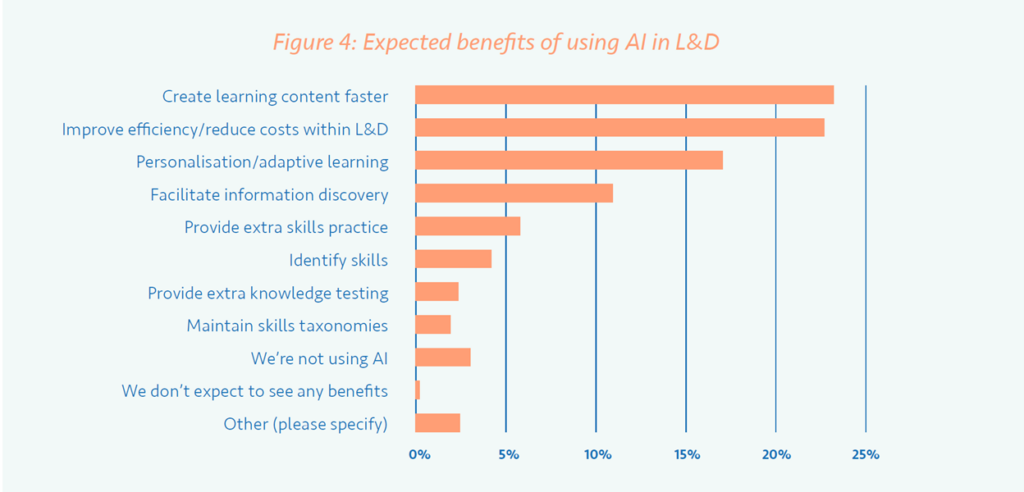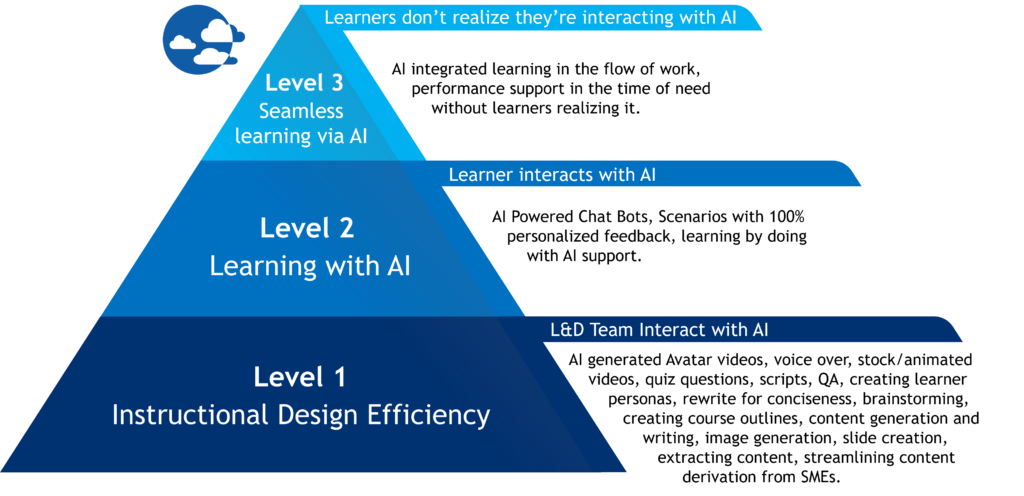As we start the year, it’s clear that the L&D trends for 2024 will bring significant developments to corporate learning. Organizational agility is now key for business success in the rapidly evolving landscape. From the countless conversations I’ve had around the globe and through the You in 2042 podcast, it’s apparent that Learning and Development (L&D) has a role to step up and play this year.
Economic Backdrop
The global economy saw unexpected growth in 2023, with the U.S. exceeding its previous performance, despite challenges such as rising interest rates and geopolitical conflicts. Canada experienced modest growth due to higher household debt and consumer spending pressures. Analysts expect a global economic slowdown in 2024 but not a recession. High interest rates may persist until late 2024, necessitating strategic corporate planning. In this economic climate, L&D can lead by introducing programs to enhance adaptability and face emerging trends.
This approach to corporate education helps ensure that businesses are not only prepared to meet the challenges of the present but can embrace the opportunities of the future. As we start 2024, the interplay of organizational agility and L&D initiatives is set to redefine the parameters of corporate success through the following trends.
L&D Trend #1 – AI Slowly Sanctioned in the “Front Door”
Enterprises are starting to fully embrace Artificial Intelligence in 2024, overcoming historical hesitations. Akin to past initial resistance to cloud storage in the 2000s, enterprises are now gearing up to sanction AI use. Tools that are more easily enterprise-sanctioned, like Bing Co-Pilot or features within Microsoft’s Azure suite, are becoming integral for L&D teams, offering near-term, cost-effective alternatives to more expensive options like ChatGPT Enterprise.
L&D Trend #2 – AI Sneaking in the “Back Door”
Beyond official adoption, there’s an undercurrent of AI use enhancing the speed and efficiency for forward-leaning learning professionals. Individuals have started using AI features in licensed tools like Storyline, Vyond, and Adobe to enhance their L&D team’s efficiency. This is a L&D 2024 trend that will continue throughout the year.
L&D Trend #3 – Incremental AI Use vs. Transformative AI Learning
This initial step to speed up the work L&D team’s currently perform is apparent from the Beyond the Sky L&D + AI Community of Practice and is also echoed in the Donald Taylor and Egle Vinauskaite’s AI in L&D: The State of Play report that purports that the majority of respondents are using AI to create learning content faster and more efficiently. Most respondents are examining their current L&D tasks, particularly the time-consuming ones, to see how AI might streamline the workflow

Source: The L&D GSS Focus Report 01. www.donaldhtaylor.co.uk/the-research-base/
This includes examples of what I’ll call “level 1” Incremental AI-use that are centred around improving the efficiency of instructional design teams and learning departments, such as creating instructional materials, videos, and quiz questions. I foresee a proliferation of adoption for these “level 1” tools. Solutions like image generation, or Synthesia and Colossyan for video creation, integrated into platforms like Storyline AI and RexAI by the Regis Company, are gaining traction and help with this incremental AI use and easy adoption.

In contrast, I see only a handful of organizations in 2024 being ready to embrace “Level 2” AI Learner Interaction whereby learners use AI-powered tools directly to gain skills or perform their tasks. Among others, examples include Beyond the Sky’s AI-Powered Storyline scenarios (password BTS123), Mobile Coach’s AI chatbot, and the Situation Expert problem solving platform, by the late Ray Jimenez who was passionate about people learning by doing and learners interacting directly with Chat GPT. Consider what AI in L&D level you would like your organization to be playtesting in.
Trend #4 – Internal Practitioners Being Left Behind
With these types of AI use in L&D, a digital divide is emerging between L&D professionals in organizations and their more experimentally-inclined peers and vendors. This will only exacerbate in 2024.
While internal teams wait for official permission to use AI, their counterparts in the vendor space are quickly advancing, leading to a knowledge gap that requires thoughtful vendor selection to prevent potential pitfalls. It also highlights the need for those in corporate roles to stay abreast of the technology and learn from peers.
Trend #5 – Proliferation of Bad Training Due to AI Tool Misuse

With AI’s growing influence in eLearning, there is a risk of creating generic content without proper instructional design, especially among business leaders and Subject Matter Experts (SMEs) eager to bypass traditional L&D processes. Organizations need to balance the use of AI tools with human creativity and intervention to maintain the quality and relevance of learning content.
There’s a number of non-L&D business leaders I’ve spoke with who are excited about the ability to quickly “generate training” via slide decks and long talking head videos. The challenges they experience with L&D teams such as perceived insubordination of L&D not creating training right away but insisting on “needs analysis” and other “bureaucracy” are alleviated with AI-training generation tools. Furthermore, the AI tools allow them to “generate training” at a fraction of the time, with full control, and with the ability to bypass the laborious L&D teams.
This should be a warning signal to those in L&D. Without grounding in instructional design principles, this could result in a surge of ineffective training materials, diluting the quality of performance-driven learning solutions and diminishing the role of L&D. Any respect and gains L&D has gained on creating solutions that drive performance are at risk.
Trend #6 – Doing More with Less
This trend is exacerbated by anticipated job cuts, especially in L&D, that may lead to a resurgence of traditional, less effective training methods. Business units, seeking control over training content, might prioritize speed and cost over quality, further diluting the strategic depth at L&D leadership levels. Without informed training teams left to challenge what happens with learning and development, it will be difficult to drive long-term performance.
Trend #7 – The Trusted Learning Advisor Solution
In an era where anyone can create training content and shrinking L&D departments, the need for strategic L&D expertise is more pronounced. The key response is for L&D professionals to evolve into Trusted Learning Advisors, In his book of this topic, Dr. Keith Keating outlines practical steps and case studies to support L&D professionals on this journey from order-takers to trusted learning advisors.
In this capacity, one can ensure that learning initiatives align with business objectives and genuinely contribute to employee development and organizational success. As such, we must engage in early, strategic discussions to guide talent development, rather than passively accepting orders. This proactive approach is crucial to maintain relevance in an era where AI offers easy but often subpar training alternatives. The call to action is now.
Trend #8 – Data-Based Decisions
One aspect of being a Trusted Learning Advisor is making data-based decisions. The integration of more easily accessible AI-powered data analytics is transforming how training effectiveness is gauged and optimized. Real-time analytics from Learning Management Systems enable L&D professionals to address learning hurdles, while predictive analytics and personalized learning paths allow for anticipatory and tailored educational experiences.
Because of more widespread use of AI, skill gap analysis is more easily attained. This identifies and targets areas for development, ensuring training meets current and future needs. Evaluating training impact through data helps in measuring program success and calculating Return on Investment (ROI), ensuring L&D strategies contribute tangibly to organizational goals. Leanring professionals have been trying to do this analysis for some time and in 2024 the tools to enable them will be more apparent.
Trend #9 – Accessibility Going Beyond the Basics
Some of the analytic support helps drive other areas on L&D’s “to do” list. At long last, there’s an increasing mandate for comprehensive accessibility in training materials. Closed captioning is no longer enough; there’s a push for descriptive captioning, full color contrast compliance, fully functional keyboard controls, and scalable text to accommodate a wider range of needs. These should have been requirements for awhile, but 2024 is the year when they are more fully enforced.
Trend #10 – XR/AR/VR Falling Off the Radar
While there is focus on data based decisions and regulatory accessibility obligations, other perceived “nice to have” aspects of L&D will dimmish in priority against a fiscally restrained work environment. High-quality applications of XR/AR/VR continue to be developed; however, the return on investment (ROI) remains challenged, especially in a financially restrained environment. The focus is shifting to specific use cases where the technology can replace costly or dangerous real-world scenarios.
Conclusion
In conclusion, 2024 is set to be a pivotal year for L&D, with AI integration and the evolution of training methodologies at the forefront. The challenge for L&D professionals is to adapt and lead in this changing landscape, ensuring that training remains effective, relevant, and accessible.


Recent Comments